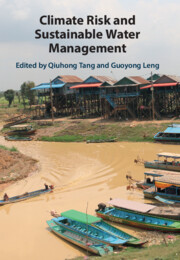Book contents
- Climate Risk and Sustainable Water Management
- Climate Risk and Sustainable Water Management
- Copyright page
- Contents
- Contributors
- Preface
- Acknowledgements
- Part I Water-Related Risks under Climate Change
- 1 Pluvial, Fluvial and Coastal Flood Risks and Sustainable Flood Management in the Pearl River Delta under Climate Change
- 2 Flooding Risk in the Lancang-Mekong River Basin under Global Change
- 3 Spatial Drought Patterns in East Africa
- 4 Assessment of Global Water Erosion Vulnerability under Climate Change
- 5 Water Erosion and Its Controlling Factors in the Anthropocene
- 6 Climate Change Impacts on Saltwater Intrusion into Coastal Aquifers
- Part II Climate Risk to Human and Natural Systems
- Part III Sustainable Water Management under Future Uncertainty
- Index
- References
4 - Assessment of Global Water Erosion Vulnerability under Climate Change
from Part I - Water-Related Risks under Climate Change
Published online by Cambridge University Press: 17 March 2022
- Climate Risk and Sustainable Water Management
- Climate Risk and Sustainable Water Management
- Copyright page
- Contents
- Contributors
- Preface
- Acknowledgements
- Part I Water-Related Risks under Climate Change
- 1 Pluvial, Fluvial and Coastal Flood Risks and Sustainable Flood Management in the Pearl River Delta under Climate Change
- 2 Flooding Risk in the Lancang-Mekong River Basin under Global Change
- 3 Spatial Drought Patterns in East Africa
- 4 Assessment of Global Water Erosion Vulnerability under Climate Change
- 5 Water Erosion and Its Controlling Factors in the Anthropocene
- 6 Climate Change Impacts on Saltwater Intrusion into Coastal Aquifers
- Part II Climate Risk to Human and Natural Systems
- Part III Sustainable Water Management under Future Uncertainty
- Index
- References
Summary
Water erosion has become an important problem and is expected to be affected by climate change. This study assessed the vulnerability of global water erosion during 1992–2015 based on RUSLE method. The research objective was to explore the spatial pattern of global water erosion vulnerability change in recent decades and identify the impacts of rainfall change on water erosion. The results show that global water erosion vulnerability increased over 54.23 per cent of the surface during 1992–2015, and the surface with significant increasing trends accounted for 11.96 per cent. There is great heterogeneity in the trends across the world. The change rate of water erosion vulnerability on croplands and bare lands was significantly higher than that of natural vegetation. Most areas exhibiting statistically significant trends were in cold and arid climate zones (CZs), which indicates that bare lands and croplands in cold and arid CZs were more sensitive to climate change with regard to water erosion. The results offer a global view of impacts of rainfall change on water erosion and suggest that enhancing the vegetation growth and taking soil conservation measures on croplands and bare lands in the cold and arid CZs could reduce the erosion threat.
- Type
- Chapter
- Information
- Climate Risk and Sustainable Water Management , pp. 65 - 81Publisher: Cambridge University PressPrint publication year: 2022

